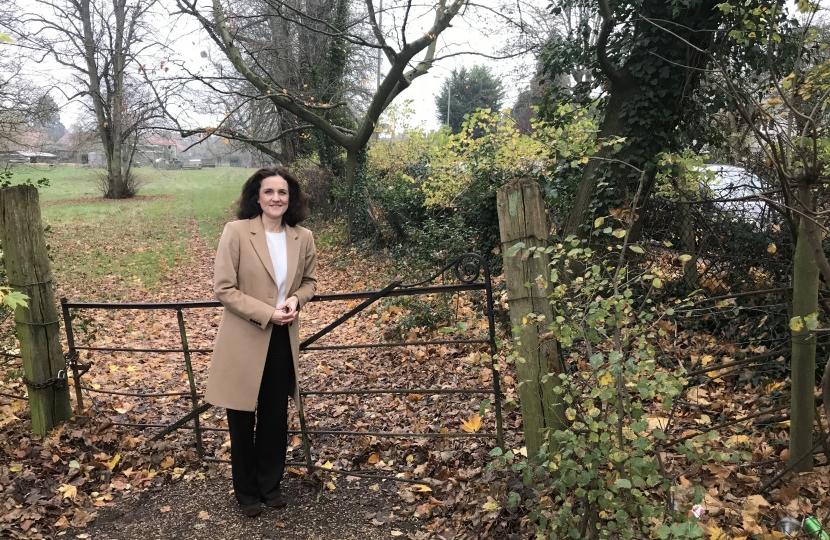
Theresa Villiers has issued the following appeal for help to save the agricultural fields at Whalebones in High Barnet, which are under threat from developers. It sets out what you can do to try to save Whalebones:
"If you want to save the fields at Whalebones in High Barnet, can I strongly encourage you to submit an objection to Barnet Council’s planning committee? I’m campaigning against plans by Hill Residential to build 152 flats and houses at Whalebones. This would involve a tragic loss of open fields and wildlife habitats in the heart of the suburbs.
You can help stop this from happening by making your voice heard in the planning consultation process. The deadline for website comments on this application expired on 16th September. However, I have been assured by the council that objections will be considered up until three days before the planning committee hearing which has not yet been scheduled. So you can still have your say by emailing your views to [email protected] or posting them to Ms E Sutherland Thomas (re 19/3949/FUL), Barnet Planning and Building Control, 2 Bristol Avenue, Colindale, London, NW9 4EW. You should include the reference number for the application in your email or letter. That reference number is 19/3949/FUL.
To ensure your objection has the greatest impact, it needs to refer to valid planning law reasons to oppose the development. You may therefore wish to considering including some of the points set out in the template letter I have circulated."
Template letter of objection from Theresa Villiers
Planning Ref: 19/3949/FUL – Whalebones, Wood Street, Barnet, EN5 4BZ
I would like to express my opposition to the proposal to construct 152 new residential dwellings on the fields at Whalebones. I would urge the planning committee to reject it.
The plans to build here would amount to a serious breach of Conservation Area policy which was put in place to protect a location of significant historical and environmental importance. The scale, massing and density of the plans are inappropriate for a site of this sensitivity and amount to an overdevelopment. They would also cause unacceptable loss of wildlife habitats and biodiversity.
Breach of Conservation Area Policy
The site’s size, location and history make it especially sensitive. Although Whalebones is not designated as green belt, it includes the last remaining fields near the town centre and is an integral part of the Wood Street Conservation Area (CA).
The Conservation Area extends this far west in order to take in Whalebones as an area of special character. Paragraph 6.5 of Barnet Council’s CA Character Appraisal highlights: “The open rural character of the grounds and views in and across the site are highly important aspects of the character of the conservation area and echo the Green Belt and the open country beyond.” If the project proceeds, over half the site – most of which is currently green – would be lost to residential development. It would lose its rural character and links with the green belt and open country.
The Barnet Society sum up a fundamental objection to the plans as follows: “As well as offering important open views across the site north and south, the meadow at the west end is an essential natural and visual buffer between Chipping Barnet and Arkley; without it, they will lose their separate identities forever.” The development would thus lead to a profound change in the character of the surrounding neighbourhood, exactly the kind of change which the Conservation Area was introduced to prevent.
Overdevelopment
The number of new homes proposed will lead to an adverse effect on local traffic, adding to congestion already routinely experienced in Wood Street, particularly during rush hour and at school drop-off and pick up times. A development of this size is likely to generate far more traffic than is estimated in the documents supporting the application. The prediction that only 47 vehicles will leave the site during peak time is far too low to be realistic
The provision for parking on-site is unlikely to cover all the cars the new residents will own. If this development goes ahead, overspill parking on surrounding roads is inevitable, in an area where parking spaces are already under pressure.
The development is far too dense for such a sensitive area. It is denser than the Elmbank development next door which has 92 dwellings. The design, scale, massing and density of the development is not in keeping with the character of the surrounding area. Many of the buildings proposed (particularly the western blocks of flats) would be visually overbearing.
I am also concerned about the impact on local services and infrastructure of such a significant increase in population - possibly up to 500. This increase would add to the pressure already felt as a result of construction of substantial development next to Whalebones at Elmbank.
Environment and biodiversity
The Whalebones site provides a green lung in the middle of a built-up area which helps to fight pollution. The loss of trees and open space in this area would not help efforts to improve local air quality.
The wildlife habitat provided by the fields under threat, and the neighbouring gardens of Whalebones Park, currently supports foxes, badgers, squirrels and muntjac deer. The deer return each year during their breeding season, accessing Whalebones through neighbouring green areas. Other wildlife includes Grey Wagtails, a bird which is currently on the Red List because of declining numbers. The site is a feeding ground for the local colony of swifts, a species whose numbers have also fallen. The swift colony along this part of Wood Street is one of a handful now existing in High Barnet. The Whalebones site also supports bats and has breeding tawny owls.
All these will be at risk. The part of the site being proposed for recreation and parkland will not have the same characteristics as the area of open fields which will be built over. Rich biodiversity will be lost if this planning application is accepted.


